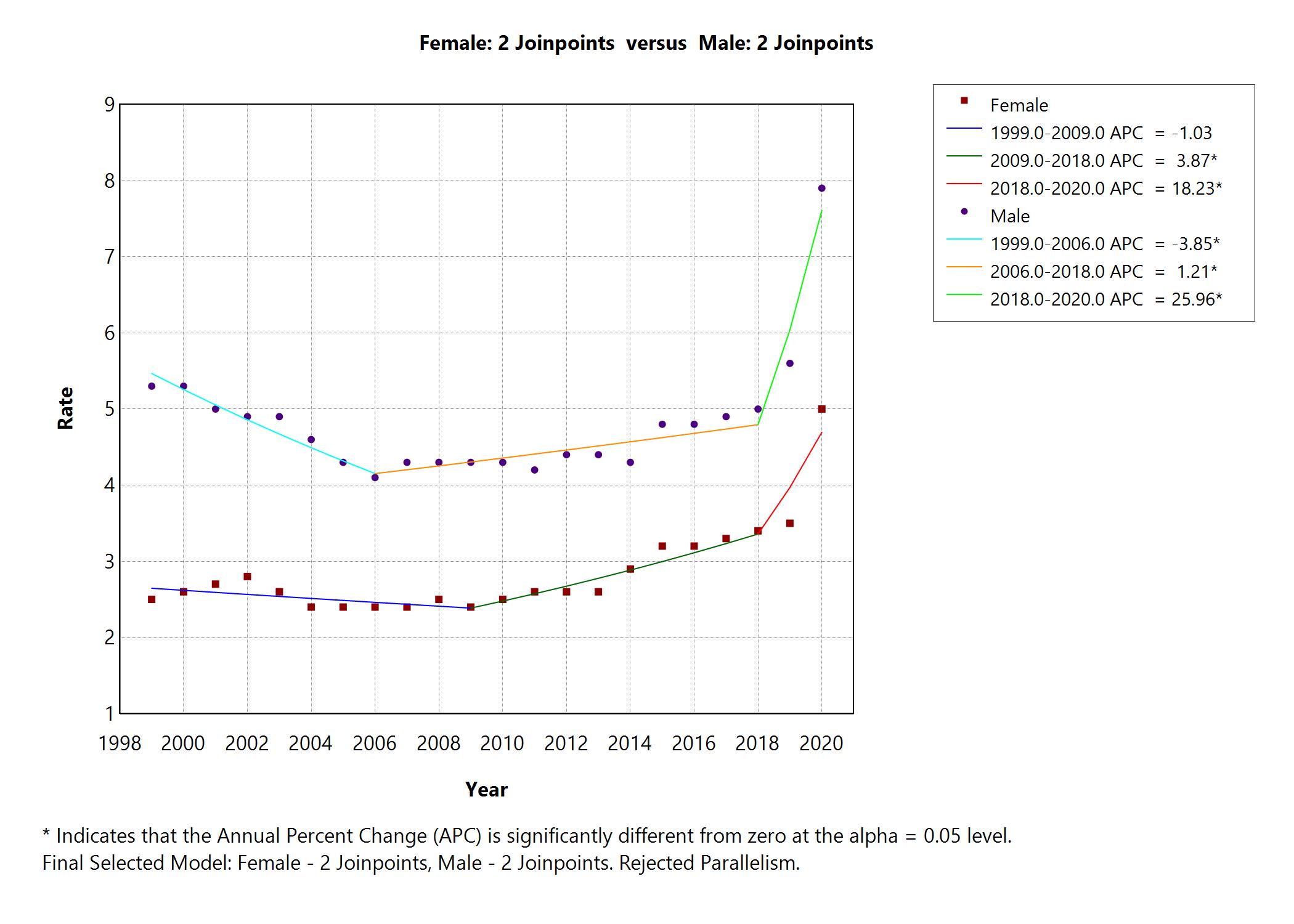Sunday Poster Session
Category: Liver
P1587 - Gender-Based Differences in Liver Disease Mortality Among Adults Aged 15-44 in the United States,1999-2020
Sunday, October 26, 2025
3:30 PM - 7:00 PM PDT
Location: Exhibit Hall

Dayana Gandi Abousaid, MD, MPH, MHA (she/her/hers)
Medical University of Plovdiv
Plovdiv, Plovdiv, Bulgaria
Presenting Author(s)
Dayana Gandi Abousaid, MD, MPH, MHA
Medical University of Plovdiv, Plovdiv, Plovdiv, Bulgaria
Introduction: Liver disease is a growing public health concern in the United States, especially for young adults. Emerging evidence also points to shifting epidemiologic patterns in women of reproductive age. However, gender-specific analyses in young adults remain limited. This study evaluates national gender trends in liver disease mortality among individuals aged 15-44 over 22 years.
Methods: This was a cross-sectional retrospective study using the CDC WONDER database from 1999 to 2020. ICD-10 codes K70-K76 were used to analyze liver-related Age-Adjusted Mortality Rate (AAMR) per 100,000 individuals. Annual percent changes (APCs) with 95% confidence intervals were calculated using Joinpoint regression for both sexes. A test for parallelism (significance threshold of p < 0.05) was also conducted to evaluate whether male and female trends differed significantly over time.
Results: A total of 99,132 deaths (female: 36,957; male: 62,175) from liver disease were reported in the U.S. from 1999 to 2020. Two joinpoints were identified for both genders, dividing the period into three distinct segments. Among females the AAMR declined slightly but not statistically significantly from 1999 to 2009 with an annual percent change (APC) of -1.03% (95% CI: -4.10 to 0.29, p = 0.097), followed by a significant increase of 3.87% per year from 2009 to 2018 (95% CI: 0.37 to 5.90, p = 0.0416), and a sharp rise of 18.23% annually from 2018 to 2020 (95% CI: 6.38 to 24.67, p < 0.0001). In males, mortality declined significantly between 1999 and 2006 (APC = -3.85%, 95% CI: -6.13 to -2.53, p < 0.0001), increased modestly from 2006 to 2018 (APC = 1.21%, 95% CI: 0.50 to 2.05, p = 0.0032), and then surged between 2018 and 2020 with an APC of 25.96% (95% CI: 18.10 to 30.72, p < 0.0001). The most pronounced increases in AAMR occurred after 2018, with the steepest rise in males. The Pairwise Comparison revealed a significant difference between male and female trends (p = 0.000444) indicating that the observed mortality trajectories were not parallel across genders.
Discussion: Liver disease mortality has increased sharply among young adults in the U.S. particularly in recent years. The post-2018 acceleration was more pronounced in males (+25.96%) than females (+18.23%), however, both were statistically significant. These findings suggest an alarming escalation in mortality underscoring the need for interventions addressing possible causes that intensified including substance use, healthcare access and socioeconomic disparities.

Figure: Joinpoint regression analysis of the age-adjusted mortality rate (AAMR) for liver disease (ICD-10: K70-K76) per 100,000 population among females versus males aged 15-44 years in the United States, 1999-2020.
Disclosures:
Dayana Gandi Abousaid indicated no relevant financial relationships.
Dayana Gandi Abousaid, MD, MPH, MHA. P1587 - Gender-Based Differences in Liver Disease Mortality Among Adults Aged 15-44 in the United States,1999-2020, ACG 2025 Annual Scientific Meeting Abstracts. Phoenix, AZ: American College of Gastroenterology.
Medical University of Plovdiv, Plovdiv, Plovdiv, Bulgaria
Introduction: Liver disease is a growing public health concern in the United States, especially for young adults. Emerging evidence also points to shifting epidemiologic patterns in women of reproductive age. However, gender-specific analyses in young adults remain limited. This study evaluates national gender trends in liver disease mortality among individuals aged 15-44 over 22 years.
Methods: This was a cross-sectional retrospective study using the CDC WONDER database from 1999 to 2020. ICD-10 codes K70-K76 were used to analyze liver-related Age-Adjusted Mortality Rate (AAMR) per 100,000 individuals. Annual percent changes (APCs) with 95% confidence intervals were calculated using Joinpoint regression for both sexes. A test for parallelism (significance threshold of p < 0.05) was also conducted to evaluate whether male and female trends differed significantly over time.
Results: A total of 99,132 deaths (female: 36,957; male: 62,175) from liver disease were reported in the U.S. from 1999 to 2020. Two joinpoints were identified for both genders, dividing the period into three distinct segments. Among females the AAMR declined slightly but not statistically significantly from 1999 to 2009 with an annual percent change (APC) of -1.03% (95% CI: -4.10 to 0.29, p = 0.097), followed by a significant increase of 3.87% per year from 2009 to 2018 (95% CI: 0.37 to 5.90, p = 0.0416), and a sharp rise of 18.23% annually from 2018 to 2020 (95% CI: 6.38 to 24.67, p < 0.0001). In males, mortality declined significantly between 1999 and 2006 (APC = -3.85%, 95% CI: -6.13 to -2.53, p < 0.0001), increased modestly from 2006 to 2018 (APC = 1.21%, 95% CI: 0.50 to 2.05, p = 0.0032), and then surged between 2018 and 2020 with an APC of 25.96% (95% CI: 18.10 to 30.72, p < 0.0001). The most pronounced increases in AAMR occurred after 2018, with the steepest rise in males. The Pairwise Comparison revealed a significant difference between male and female trends (p = 0.000444) indicating that the observed mortality trajectories were not parallel across genders.
Discussion: Liver disease mortality has increased sharply among young adults in the U.S. particularly in recent years. The post-2018 acceleration was more pronounced in males (+25.96%) than females (+18.23%), however, both were statistically significant. These findings suggest an alarming escalation in mortality underscoring the need for interventions addressing possible causes that intensified including substance use, healthcare access and socioeconomic disparities.

Figure: Joinpoint regression analysis of the age-adjusted mortality rate (AAMR) for liver disease (ICD-10: K70-K76) per 100,000 population among females versus males aged 15-44 years in the United States, 1999-2020.
Disclosures:
Dayana Gandi Abousaid indicated no relevant financial relationships.
Dayana Gandi Abousaid, MD, MPH, MHA. P1587 - Gender-Based Differences in Liver Disease Mortality Among Adults Aged 15-44 in the United States,1999-2020, ACG 2025 Annual Scientific Meeting Abstracts. Phoenix, AZ: American College of Gastroenterology.
